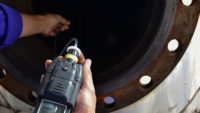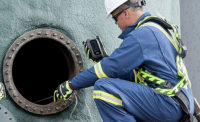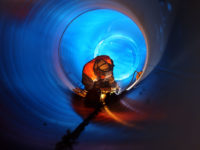When it comes to rescue operations, few scenarios pose as many challenges as confined spaces. Extracting workers from those tight, often hazardous environments requires meticulous planning and execution. Dialing 911 is not a plan.
Below, we explore the critical aspects of a confined space rescue plan to help you craft an effective strategy.
What is a confined space rescue plan?
A confined space rescue plan is a thoroughly crafted strategy outlining the procedures, equipment, and personnel required to safely extricate individuals from confined spaces in the event of an emergency. Confined space rescue plans are essential for work environments such as oil rigs and refineries, wastewater treatment plants, and other industries requiring workers to go into areas with limited or restricted entry or exit points and are not designed for continuous occupancy. These spaces can include sewers, tanks, and tunnels.
Why is a confined space rescue plan important?
Confined spaces are inherently risky. Apart from being constricting and uncomfortable, these cramped, dark spaces are often stagnant areas where toxic and combustible gasses can accumulate.
The very nature of these spaces presents a cocktail of dangers, such as:
- Limited access and egress: Escape routes are often narrow or nonexistent, making them difficult to evacuate quickly.
- Atmospheric hazards: Poor ventilation can lead to oxygen depletion, toxic gas build-up, or combustible environments.
- Structural hazards: The potential for collapsing walls, falling objects, and unstable structures pose constant threats.
- Engulfment hazards: Liquids and granular materials can potentially engulf and suffocate workers and rescuers alike.
- Falling hazards: Limited space and poor visibility can increase the risk of falls from ladders or platforms.
Confined space incidents can quickly escalate into life-threatening situations without the proper safety procedures. A well-developed plan not only helps in efficiently reducing individuals occupying the space, but also minimizes the risk of injuries and fatalities.
OSHA standards
The Occupational Safety and Health Administration (OSHA) mandates specific standards for confined space work. A crucial element of these standards is having a written rescue plan for all permit-required confined spaces.
The confined space rescue plan must address several key points:
- Identified hazards: The plan should comprehensively list all potential hazards specific to the confined space, including atmospheric hazards, engulfment risks, and falling hazards.
- Rescue procedures: Different situations require different approaches. The plan should detail self-rescue procedures for minor incidents, non-entry rescue techniques for situations where entering the space is too risky, and full-blown confined space entry and rescue protocols for when rescuers must enter the confined space.
- Required equipment: The plan should specify the equipment necessary for each type of confined space rescue, including personal protective equipment (PPE) like respirators and harnesses, gas detection devices, winches and tripods for lifting, and communication tools. The tools and equipment must be readily at hand before entry.
- Rescue team: The plan should identify trained and qualified rescue team members, outlining their roles and responsibilities during an emergency. It’s important to note that technical rescue personnel are often trained in confined spaces for years before they’re deemed competent to evaluate and perform rescue procedures.
OSHA’s emphasis on a written confined space rescue plan underscores the importance of documentation and clarity in rescue procedures. Aside from being a concrete reference during emergencies, a documented plan facilitates training, drills, equipment maintenance, and periodic reviews to ensure ongoing preparedness.
Types of confined space rescue procedures
Let’s dive deeper into the three main confined space rescue procedures:
- Self-rescue: This involves providing workers with the tools and training necessary to extricate themselves from confined spaces. This may include pre-installed equipment like lifelines or escape hatches. Gas monitors can also be crucial in alerting a confined space team to hazards that are present as they enter or may develop during their work.
- Non-entry rescue: This method is strategically employed to minimize the number of individuals entering potentially hazardous environments. Rescue teams use equipment, such as tripods, winches, and other retrieval devices, to safely extract compromised individuals without endangering themselves.
- Full-blown confined space entry and rescue: This method is typically reserved when the first two confined space rescue procedures aren’t feasible. This type of rescue operation requires highly trained rescue teams, specialized equipment, and adherence to strict safety protocols. Communication and continuous monitoring of environmental conditions, including air quality and potential hazards, are critical during this type of rescue procedure.
Additionally, the entry rescue team should have, at the very least, three key members:
- An attendant capable of executing non-entry rescue procedures
- A rescue entry supervisor who’s aware of all confined space hazards and can verify safe entry conditions
- A highly trained confined space entrant who understands the hazards and has all the necessary PPE
Whether relying on self-rescue, non-entry rescue, or full-blown confined space entry and rescue, the goal is to swiftly and safely extricate individuals from confined spaces while minimizing risks to both the rescuers and those in need of assistance. The choice of rescue method depends on factors such as the nature of the confined space, the available equipment, and the level of training and expertise of the rescue personnel involved.
Developing a confined space rescue plan
Crafting an effective confined space rescue plan involves careful consideration of the hazards and conditions unique to the work environment. Below are some best practices for developing a comprehensive plan.
Risk assessment
Conduct a thorough risk assessment of the confined space, identifying potential hazards, entrance/exit points, and rescue challenges. This can involve using gas detectors to test the area for atmospheric hazards. This information forms the basis for developing appropriate rescue procedures.
Training and certification
Ensure rescue personnel are adequately trained and certified in confined space rescue operations. Training should cover hazard recognition, proper use and inspection of equipment, and effective communication.
Communication protocols
Establish clear communication protocols to facilitate coordination between rescue teams, workers inside the confined space, and external support personnel. Reliable communication is vital for swift and effective rescue operations.
Regular drills and exercises
Conduct regular rescue drills and exercises to test the rescue plan's efficacy and identify areas for improvement. This practice helps keep rescue teams well-prepared and enhances their response capabilities.
Update and review
Periodically review and update the confined space rescue plan to account for changes in the work environment, equipment, or personnel. An outdated protocol may lead to inadequate responses during emergencies.
A comprehensive rescue plan provides a solid foundation for implementing a swift and effective response to confined space incidents. However, your contingency plan will only be as good as the safety equipment you have. Invest in quality safety equipment such as gas monitors, fall protection, and retrieval devices to ensure your personnel can execute safety protocols properly.



